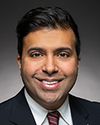Thank you very much.
I would now invite Mr. Geoffroy to give us five minutes—
Evidence of meeting #16 for Public Safety and National Security in the 44th Parliament, 1st Session. (The original version is on Parliament’s site, as are the minutes.) The winning word was extremism.
A recording is available from Parliament.
12:20 p.m.
Liberal

The Chair Liberal Jim Carr
Thank you very much.
I would now invite Mr. Geoffroy to give us five minutes—
12:20 p.m.
A voice
He's not here.
12:20 p.m.
Liberal

The Chair Liberal Jim Carr
Well, believe me, we will not have any difficulty filling up the vacuum. Let's go right to a round of questions. We're going to get through the full first round, and then we'll see how much time is left over.
We'll start with Mr. Shipley.
Sir, you have six minutes. The floor is yours.
12:25 p.m.
Conservative

Doug Shipley Conservative Barrie—Springwater—Oro-Medonte, ON
Thank you, Chair, and thank you to the witnesses for being here today.
Just as we're going on the fly a little bit, I did have a full list of questions for Mr. Geoffroy, so if I do run a little short, maybe one of my colleagues will fill in for me, just in the last couple of minutes.
I would like to start off with Mr. Gosselin.
Mr. Gosselin, your community-led organization, as you said, seeks to prevent radical violence and hateful behaviours by mobilizing members and resources of the community. Could you please tell us about some of the success stories you've had?
12:25 p.m.
Scientific and Strategic Director, Centre for the Prevention of Radicalization Leading to Violence
Thank you for your question, Mr. Shipley.
Most of the cases are confidential, so we can't make them public. It is very difficult to evaluate the success of a prevention program like this, as we cannot compare this situation to a situation where there is no program. If a program works, it should be implemented.
That said, we have collected testimony from people who have been militants or sympathizers within jihadist movements, in this case people who wanted to go to Syria. They were accompanied by the centre, reintegrated into society and wanted to share their experience. We published their testimony anonymously as part of the “MY STORY” project. In some cases, this took the form of comic strips. There was also the “What if I was wrong?” campaign, which shows how our guidance of former neo-Nazi activists encouraged them to move on, to reintegrate into society, to tell their stories and to move beyond hatred.
We really work on a case‑by‑case basis. It gives rise to many such testimonies. However, we would need a broader evaluation program to get a clearer picture of which projects work best.
12:25 p.m.
Conservative

Doug Shipley Conservative Barrie—Springwater—Oro-Medonte, ON
Thank you for that, and for the good work you're doing in that area.
Knowing that you are a hands on group, Mr. Gosselin, could you tell me a little bit about your research and what you're seeing—the background research you are doing into the social, familial and individual factors that are associated with the emergence of these extremist groups in Canada? More simply put, what is the root cause?
12:25 p.m.
Scientific and Strategic Director, Centre for the Prevention of Radicalization Leading to Violence
It is very difficult to point to a single cause. In general, studies on counterterrorism have previously blamed disadvantaged and marginalized groups. However, it is the sense of marginalization, real or perceived, that is the main factor that makes people vulnerable to radicalization. At the time, we saw in the jihadist movements a lot of second-generation youth who were born in Canada and who, as they came of age, realized as practising Muslims that things were very difficult for them because of the hatred that they were experiencing. That was a big part of pushing them towards radicalization.
The same is true of immigration and far-right movements. Many people feel that immigration will take something away from them, make them lose something. This is not borne out by research, but it is this feeling of marginalization that is important. There are also a lot of other vulnerability factors, including family ties, which are very important. What we see is that when people who have good family ties embrace extremism, they are less likely to turn to violence. The general polarization of societal debates is another very important factor.
I think these are the main factors behind the trends we are seeing in Canada right now.
12:25 p.m.
Conservative

Doug Shipley Conservative Barrie—Springwater—Oro-Medonte, ON
Thank you for that, sir.
Now I'd like to jump to Dr. Rogers if I could, just for a couple quick questions.
Mr. Rogers, how do you determine something to be disinformation?
12:25 p.m.
Executive Director, The Global Disinformation Index
Thank you for the question. It's a great question.
We spend a lot of time at the GDI thinking through how we define the problem. I think so many of the mainstream or common definitions of disinformation lie in a sort of false dichotomy of true and false. People say that disinformation is intentionally lying on the Internet, but I always say that this sort of simplistic definition doesn't pass what I like to call “the Santa Claus test”, meaning that if it were really just about someone intentionally lying on the Internet, we would be clamouring to deplatform every mention of Santa Claus, and we're clearly not doing that.
We look at disinformation through the lens of what we call “adversarial narrative conflict”. This is anytime someone is peddling an intentionally misleading narrative, either implicitly or explicitly, often using combinations of cherry-picked elements of the truth combined with falsehoods. Quoting someone who said something, and saying, “Well, that was just quoting them accurately,” without presenting a fuller picture is an example of cherry-picking an element of the truth to craft a potentially misleading narrative.
Any time someone is intentionally peddling one of those misleading narratives that, in our view, is adversarial against an at risk group or individual, an institution like science or medicine, or a democratically elected government and that, most importantly, carries with it a risk of harm, that to us is disinformation.
12:30 p.m.
Executive Director, The Global Disinformation Index
We tend to identify disinformation by a specific narrative rather than just a—
12:30 p.m.
Liberal

The Chair Liberal Jim Carr
Thank you.
Now I'll move to Mr. Noormohamed.
Sir, you have a six-minute slot. The floor is yours.
March 31st, 2022 / 12:30 p.m.
Liberal

Taleeb Noormohamed Liberal Vancouver Granville, BC
Thank you very much, Mr. Chair. And thanks to all of our witnesses.
Mr. Rogers, while you were talking, there was so much you said that actually was very troubling. The issue related to the ways in which there are 501(c)(3) designations for charitable organizations that are clearly anti-Muslim, and so on and so forth, and the fact that it is so easy for people to profit off the sale of hate-filled items.
I did a quick Google search while you were talking. It was uncomfortably easy to buy symbols of hate, whether they be swastikas or t-shirts supporting the KKK, and so on and so forth. What tools do we have available, and what tools should we have available to ensure that people are not profiting off the sale of these symbols that promote hate and, by extension, help to build this populous narrative around the symbols as being something special rather than what they are, which is truly hateful symbols?
12:30 p.m.
Executive Director, The Global Disinformation Index
Thank you. That's a fantastic question.
I feel like all of these phenomena are the result of these larger issues with the modern tech business model, one of audience attention capture and monetization. When you look at the sale of these goods, it's all about different strategies for monetizing audiences and capturing that audience attention. They use the increasingly extremist content because it tends to also drive higher engagement.
To me, one of the most important interventions lies around platform liability, and unfortunately probably all of the sites that you look for this merchandise are American companies. They have this relatively ahistoric and blanket liability waiver in the United States around the things that are carried on those platforms. Looking at platform liability for the kinds of things that these platforms carry, even if they're not explicitly selling them themselves, is to me one of the most important aspects of this. Platforms have policies sometimes, but when those policies either go unenforced or don't exist, they are generally shielded from liability for that, and I think that's what really needs to change.
12:30 p.m.
Liberal

Taleeb Noormohamed Liberal Vancouver Granville, BC
Moving forward and following on that, seeing what happened in the United States—you mentioned January 6—we've obviously seen some very concerning trend lines in Canada around conspiracy theories and around misinformation that then leads to action. One of the things that I'm very curious about, which I know many of my colleagues may be, is the role of political leaders in ensuring that they are not helping to feed these movements. What in your view should be the responsibility of elected officials in ensuring that they are not feeding these narratives, which then lead to pretty dangerous action?
12:30 p.m.
Executive Director, The Global Disinformation Index
That's a very interesting question. I haven't spent a lot of time thinking about that, only because our organization tends to focus on the business model side of things, the tech industry change that we advocate for. As a general statement, I would say that politicians, like others in prominent places, have an outsized voice and thus an outsized reach and presence in our modern information environment. I guess it would just suffice to say that with great power comes great responsibility, especially when there's an obvious kind of path from whatever is being said towards an expectation or risk of harm.
12:35 p.m.
Liberal

Taleeb Noormohamed Liberal Vancouver Granville, BC
Let's go back to the business model piece. I'm a tech guy. I used to run marketplaces. I know this model well. In the companies that I worked in, we always made a commitment to make sure we weren't selling those types of products.
How do we, as elected officials, work with these platforms to make sure they understand the consequences—whether it is the carrot or it's the carrot-and-stick combination—to ensure that there is this sense that you can't get away with letting this stuff happen and pretending it doesn't have a long-term consequence on the way in which people behave? What should we be doing? How should we be acting? What are some of the tools we should be using, whether it's carrot or stick, in making that conversation something platforms that are selling products need to be engaged in?
12:35 p.m.
Executive Director, The Global Disinformation Index
It's an excellent question. Thank you.
You said “carrot and stick”, and I think there are two elements that can help industry tackle this better.
One is for better definitions. That's a place where industry has a lot of trouble. In the U.S., a lot of these groups, unfortunately, have charity designations, so now you're asking commercial companies to go against their official government designation. Having better definitions and stronger enforcement around those definitions is one area that I think would really help industry.
The other area is around, as I said, liability. Platforms currently enjoy this blanket and ahistoric liability waiver, at least in the United States. If that could change, that would be the stick side of things, to actually enforce real product liability for these platforms, their algorithms, their marketplaces, etc., that they currently don't have.
12:35 p.m.
Liberal

Taleeb Noormohamed Liberal Vancouver Granville, BC
Thank you very much.
I'll give the time back to the chair.
12:35 p.m.
Liberal

The Chair Liberal Jim Carr
I'll take it. Thank you.
We'll move right to Ms. Larouche.
You have a full six-minute slot. Whenever you're ready, the floor is yours.
12:35 p.m.
Bloc

Andréanne Larouche Bloc Shefford, QC
Thank you very much, Mr. Chair.
I would also like to thank the two witnesses who are part of the second group of witnesses that we are welcoming.
My first question will be to Mr. Gosselin.
I would like to hear from you on the issue of the carrot and stick that my colleague mentioned. It is interesting, because we sometimes tend to believe that it is difficult to get individuals out of radicalization, whereas the work done by your centre seems to show that certain things can be done. It's more about the carrot than the stick, because your centre works to educate people.
I would like to hear from you also about the difficulties around evaluation. You talked about the importance of having a much broader evaluation program.
What exactly do you mean by that? I'll come back to the stick next.
12:35 p.m.
Scientific and Strategic Director, Centre for the Prevention of Radicalization Leading to Violence
Thank you, Ms. Larouche.
We do not pretend that it is easy to help people move away from extremism or re‑engage in a sociable way. On the contrary, it is extremely difficult and must be done on a voluntary basis. However, it is always possible, as there are always moments when an individual doubts their commitment and ideas and questions themselves. There must be organizations present to support this reflection and journey.
You talk about the carrot. Indeed, we work first to help people. We know that these are people who sometimes decide to act in a despicable, anti-social or violent way, but they are also people who have gone there because some of their needs were not being met. So that is what we work towards.
With regard to evaluation, there are issues relating to confidentiality. In addition, having to work in a hurry also creates problems, and it is always very difficult to have very effective measurement tools. This is a problem for radicalization prevention organizations around the world. It's very difficult to show beyond a shadow of a doubt that a program has led to a person disengaging. There are some good indicators that can point to this, but the agencies that do this work often have very limited resources and spend most of those resources on the programs themselves and spend far less on evaluation.
It is in this sense that more global support is needed.
12:40 p.m.
Bloc

Andréanne Larouche Bloc Shefford, QC
Several centres in Quebec have developed expertise. Some of these centres focus on the study of radicalization.
I would now like to hear a little more about the carrot and stick principle, because the issue has been discussed at the Standing Committee on Public Safety and National Security, as well as the Standing Committee on the Status of Women.
In your presentation, you slipped in a quick word about the importance of legislating in the area of online hate. So obviously, we're a little bit more on the “stick” side when it comes to penalizing individuals who indulge in hate speech. As I said, it could be important to do that. There's also the whole issue of the platforms that allow all these extremist groups to be funded.
On the legislative front, what kind of action in particular would your organization like to see at the federal level?
12:40 p.m.
Scientific and Strategic Director, Centre for the Prevention of Radicalization Leading to Violence
Our organization is not really in a position to recommend any particular type of measure, but it is clear that the issue of online hate and violent speech is very important. We see that it causes really significant damage. We did a study that showed that hateful acts experienced online were generally, at least in our sample, seen as more serious and more damaging than those experienced in person, which is a bit counterintuitive.
It is very clear that an assault, a punch or any form of physical violence will have to be criminalized and punished, but it is not necessarily this form of violence that causes the most harm when we talk about hateful acts. The consequences of such acts are an often permanent damage to the sense of security, which can affect an entire community. The real issues are the damage to self-confidence, to one's place in society and to the social fabric.
While we cannot necessarily recommend any particular measure, we obviously support the idea that online hate should be treated seriously by legislators.
12:40 p.m.
Bloc

Andréanne Larouche Bloc Shefford, QC
You said you were working more on rehabilitation and prevention, but you've probably heard stories about extremely difficult online language. We know that legislation is expected on the subject and we hope that it can still succeed in changing things.
In my second round, we may have the opportunity to revisit the most important factors underlying radicalization that have been observed since the beginning of the pandemic as well as to hear what you have to say on the subject.